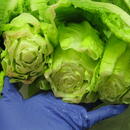All
What is perchlorate?
Perchlorate is an industrial chemical. In the US it is used as primarily as an ingredient in rocket fuel, and in fireworks and flares. Perchlorate has also been found to occur naturally.
Does food contain perchlorate?
- There is a potential for perchlorate contamination in food, most likely through the use of contaminated irrigation water, processing water, and via sources used for bottled water (which is a 'food' regulated by US Food & Drug Administration [FDA]). However, FDA does not know the relative contribution of any particular source of perchlorate to that found in foods. Recognizing this potential for perchlorate contamination in food, FDA conducted exploratory surveys in 2004-2005 to investigate the occurrence of perchlorate in certain foods and is using the data collected in these surveys to develop preliminary assessments of human exposure to perchlorate through food; FDA has additional investigations planned. The FDA found low levels of perchlorate in milk, bottled water, and lettuce. According to the Environmental Working group, a more recent study by the Centers for Disease Control (CDC) found that Òa significant number of women are at risk of thyroid hormone depression from perchlorate exposure.
- Perchlorate at high doses (e.g., therapeutic, pharmacologic) can interfere with iodide uptake into the thyroid gland, interfering with thyroid hormone production. Sustained inhibition of iodide uptake can lead to hypothyroidism, which can lead to metabolic problems in adults and abnormal development in utero and in infancy.
Is perchlorate regulated by the government?
- There is currently no enforceable national drinking water standard for perchlorate either in Canada or in the United States, although various states have implemented guidelines or goals ranging from 1 ppb to 18 ppb for perchlorate in drinking water. In the US, the Environmental Protection Agency (EPA) requires public water systems serving more than 10,000 people (and some smaller systems) to monitor drinking water for the contaminant. As of March 2007, there are several bills under discussion in the US House and Senate requesting that the federal government establish a new drinking-water standard for perchlorate contamination.
What should I do?
- Dr. Robert E. Brackett, Ph.D., Director of the Center for Food Safety and Applied Nutrition Food and Drug Administration stated, "Consumers should not view the low levels of perchlorate in the foods tested as an indicator of the 'risk' of eating certain foods, particularly when many of the foods are important components of a nutritious and balanced diet. Some of these food items are also important sources of iodine. Until more is known concerning perchlorates occurrence in foods, FDA continues to recommend that consumers eat a balanced diet, choosing a variety of foods that are low in trans fat and saturated fat, and rich in high-fiber grains, fruits, and vegetables."
For more information, visit the FDA, CDC, or Health Canada websites.
Why Are Pesticides Used?
Farmers use pesticides to keep diseases, harmful insects, and rodents from infesting and damaging otherwise healthy crops. Without the use of pesticides, it is believed that production in every category of agricultural farming would fall and consumer prices would rise dramatically.
How Are Pesticides Regulated?
- Pesticides are regulated by the Federal Insecticide, Fungicide and Rodenticide Act (FIFRA) and the Food Quality Protection Act (FQPA).
- In order to be approved for use, pesticides must be subjected to more than 120 tests by the Environmental Protection Agency (EPA) to determine their effects on our environment and its inhabitants.
- Federal law requires all pesticide labels to include explicit directions for use and precautions to protect users, consumers, and the environment.
Is It Safe to Eat Produce Grown With The Use of Pesticides?
- The office of the Assistant Surgeon General, the National Cancer Institute, the American Association for Pediatrics, and the USDA, among others, believe that the benefits of eating fruits and vegetables far outweigh any potential risks that might be involved with ingesting foods correctly treated with pesticides.
- "Trying to avoid pesticide residues by avoiding fresh fruits and vegetables altogether is detrimental—not beneficial—to your health," says Edward Growth III, director of Technical Policy and Public Service for Consumers Union and publisher of Consumer Reports magazine.
- Markon concurs with these scientists and the majority of health professionals who support these views.
For More Information:
Centers For Disease Control and Prevention (search "pesticides")
University of California at Davis

Premature pinking is the appearance of pink or light red areas at the site where fruits and vegetables are cut and signals shortened shelf-life. It is caused by respiration, water loss, and ethylene production.
